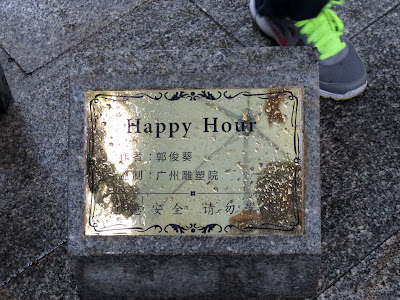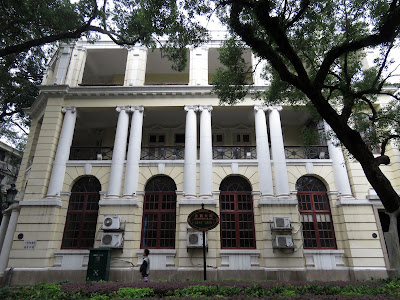
The gazetted historical area Shamian (沙面) which literally means a sandy surface, is an oval shaped sandbank island in Liwan District of Guangzhou City. The place bordered by The Pearl River in its south, was separated from the mainland by a man-made canal. In the past during Ming Dynasty (1368-1628), Shamian was an important port for foreign trades and in Qing Dynasty (1644-1911), it was a strategic defensing point for the city especially during the 1st opium war (1839-42) and 2nd opium war (1856-1860). Within 18th to 19th century, Shamian was also an anchorage for thousands and thousands of boatmen. Shamian was made into an exotic place to experience and eye witness the changes and developments of Chinese late history.


During Qing Dynasty, many westerners and foreigners lived and had their business along the bank of Pearl River at the east of the present Shamian Island. After the Opium wars in year 1859, Qing Government was forced to cede the place to England and France and divided the territory into two concession with a water canal dug at the north end to isolate it from the mainland.



The French Catholic Chapel, Our Lady of Lourdes standing on the main boulevard, was restored in year 1892 on the French side at the end of island. Another notable religious building is the British Protestant Church which was constructed in year 1865.


The quite rundown building was the former Soviet Union Consulate built in year 1916.


Beside Soviet Union, France, England, Germany, Portugal, Norway, Czechoslovakia, USA and Japan etc., were also once having their consulates locating here. Poland was the only country that kept it's consulate at Shamian until year 2014.



The buildings of ten over consulates with nine banks and forty over companies were set within a lush greenery with a beautifully upkeep Garden as a central core.



The central core point of the garden was formerly a fountain.


Western boy was having fun with Chinese clowning masks with a Chinese boy. Goodwill!



Though there are quite a numbers of new hotels, restaurants and souvenir shops setting up around the area, the tranquil avenues that lined by historical buildings flanked by shady trees, still remain a reminder to an European colonial period. Visit the site in a leisure pace, recall the past and admire the present.


I enjoyed watching all these bronze statue scattering around the site, that lively depict the customs and life of people on the island during early period. These two sculptures were showing the different greeting styles of Western and Chinese typical way.



Buildings with hipped roofs and large verandas are the former stone mansions built along the waterfronts by western traders and foreign companies.


The heritage buildings of British Guangzhou Club with shutter doors and windows on its 2nd floor, was one of the earliest clubs in China. The building next to it was once belonged to Dodwett & Co Ltd. The beauty of its architecture was the combination of western styled steel sloping roof with Chinese tradition tiles and ceramics.




The 20th century reinforced concrete building with green glazed tiles was once belong to Specie Bank of Japan and the Consulate of USA.


HSBC Bank was once in this building. The structure having balconies around the corners was built in year 1925.


The main occupant of this Victoria styled structure included Asia Oil company and German Embassy. Its courtyard was enclosed by transparent wall and 18 meters long gallery. And the other western traditional three stages building was once belonged to Sims Matterson of USA. It was built with 19th Baroque style with hip roof decorated with Guangzhou pan&roll roofing tiles in its enclosed veranda at 1st floor.




European's Happy Hour!


These two early 20th century three storey reinforce concrete framed structures are the former location of Citi Bank and Standard Chartered Bank. The Citi Bank Building has a sky bridge connecting the main halls to the auxiliary. The 6.2 meters high grand building of Standard Chartered Bank has its money safe built at the center surrounded by 80cm thick concrete wall sealed by iron plates with a double iron gate outside.




Sound of Music!




Ladies wearing colonial times tradition dress, Cheongsam of 20th century and 21st century modern hot pants, resembling the changes of period in China, is the most outstanding groups of bronze postures at Shamian Island. By their side are the statue of two business men, one Chinese and one Westerner.


A view of Pearl River




Roman Catholic Cathedral of Sacred Heart of Jesus, located in the heart of the old Guangzhou town, at Yide Road, by north bank of Pearl River, was one of the few in the world to be entirely constructed with granite including its walls, pillars and twin towels. Due to its unique architectural structure, the Gothic Cathedrals is commonly addressed as Stone House by locals. It was built during Qing Dynasty in year 1888.



I love its rice sheet Cheongfun and desert double layer milk with red bean. They really taste good.


No comments:
Post a Comment